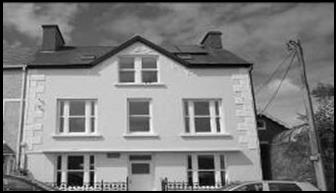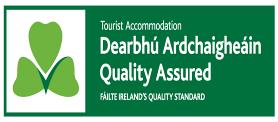|
House in Dingle |
|
An Caladh Spainneach |


|
This magnificent early 20th century house, is situated on the marina in Dingle town; one of the highlights of the recently created Wild Atlantic Way. It has been lovingly restored by the family that have owned it since it was first built.
It is available to rent for self-catering at all times during the year for groups of up to 10 people. We do not cater for hen or stag parties.
|
|
The name “An Caladh Spáinneach” in English means “The Spanish Pier”. The owners named this house after the old Spanish Pier which once stood directly outside this fine house up to the middle of the 18th Century. The name is indicative of the great medieval trade which once existed between Dingle and Spain. In the 14th and 15th Centuries, Dingle was one of a limited number of Irish ports permitted to allow wine to be imported. This resulted in greatly increased trade with Spain, France and Great Britain up to the “discovery” of America. Several notable visitors disembarked on the pier over the centuries; in 1529 King Charles V of Spain sent his personal envoy Gonzalo Fernandez to Dingle to parley with the Earl of Desmond. In 1579 James Fitzmaurice Fitzgerald led an expeditionary force from Spain landing at the Spanish Pier. The troops sailed on to Smerwick Harbour and Dún an Óir on the Dingle Peninsula where they were joined by various Irish leaders and their men. The campaign ultimately failed and they eventually surrendered to the British under Lord Grey de Wilton supervised by Sir Walter Raleigh. Also present was the poet Edmund Spenser. James Fitzmaurice Fitzgerald managed to escape and lived to fight another day. James Louis Rice from Dingle (later officer of the Irish Brigade and of Austrian Emperor Joseph II) sailed from the Spanish pier to obtain an education in Louvain (as there was no education of Catholics permitted in Ireland at the time) to study for the priesthood. He later left his studies and joined the Austrian Army. During the French Revolution he was involved in organising a daring plan to rescue Marie Antoinette (the Emperor’s sister) from Paris to bring her to Dingle in a wine ship. She refused to leave her husband King Louis the 16th at the last moment. Today the last vestiges of the Spanish pier are buried deep under many tonnes of earth and rubble since the construction of the car-park in 1989. However, prior to this the foundations were still said to be visible during the ebbing of a Spring tide, well within living memory. |

|
Click on above to see our photos |



